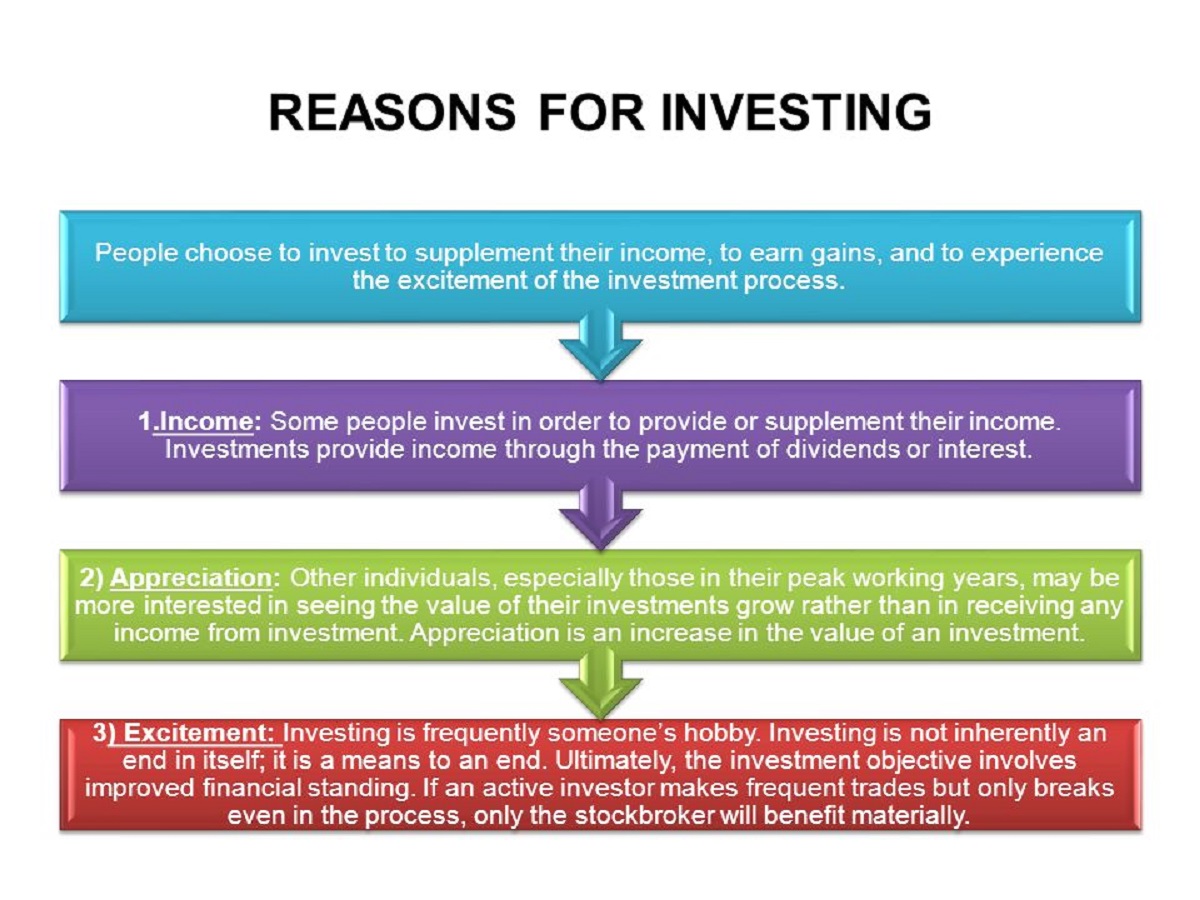Introduction
Investing is an essential part of securing your financial future. However, putting all your eggs in one basket can be risky. That’s where diversification comes into play. Diversifying your investments is a strategy that involves spreading your money across different types of assets to minimize risk and maximize returns. It is a fundamental concept in investment management that aims to reduce the impact of market volatility on your portfolio.
Diversification is based on the principle that different types of investments perform differently under various market conditions. By allocating your investments across a range of asset classes, such as stocks, bonds, real estate, and commodities, you are not relying on the performance of a single investment to determine the fate of your entire portfolio. Instead, you are creating a cushion of protection against any adverse events that may affect one particular investment or sector.
One of the main benefits of diversification is its ability to minimize risk. By spreading your investments across different asset classes and within each asset class, you are effectively reducing the impact of any one investment’s poor performance on your overall portfolio. This means that even if one investment suffers a decline, the other investments can potentially offset these losses, resulting in a more stable and resilient portfolio.
Furthermore, diversification can also help maximize returns. While some investments may experience periods of volatility or downturns, others may perform well during the same time frame. By diversifying, you increase the chances of having some investments that are performing positively, which helps to balance out any unfavorable performance in other areas. This can lead to more consistent and potentially higher overall returns.
Another advantage of diversification is the reduced dependence on a single investment. By spreading your investments across different assets, you are not relying solely on the success or failure of one company, industry, or economic sector. This can provide peace of mind knowing that your financial well-being is not entirely dependent on the performance of a single investment.
In the following sections, we will delve deeper into the importance of diversification and explore different strategies for effectively diversifying your investments.
What is diversification?
Diversification is an investment strategy that involves spreading your investments across a variety of different assets, such as stocks, bonds, real estate, and commodities. The goal of diversification is to reduce the risk of loss by spreading your investments across various types of securities and sectors.
When you diversify your investments, you are essentially creating a portfolio that is not heavily dependent on one particular investment or sector. By allocating your investments across different asset classes, you are reducing the likelihood that a decline in one investment will have a significant impact on your overall portfolio.
For example, let’s say you invest all your money in a single stock. If that stock performs well, you stand to make a significant profit. However, if the stock performs poorly, you could face substantial losses. On the other hand, if you diversify your investments and spread them across various stocks, bonds, and other assets, the impact of any one investment’s poor performance is minimized.
Diversification also helps to protect your portfolio against market volatility. Different types of investments respond differently to market conditions. For example, during periods of economic downturn, stocks may perform poorly, while bonds and other fixed-income investments may hold their value or even increase in price. By diversifying across different asset classes, you can hedge against the risk of a specific investment underperforming during a particular economic cycle.
It’s important to note that diversification alone does not guarantee profits or protect against losses. It is still possible to experience losses even with a diversified portfolio. However, by spreading your investments across different types of assets, you are reducing the overall risk and increasing the likelihood of achieving more consistent returns over the long run.
Overall, diversification is a key strategy for mitigating risk and increasing the stability of your investment portfolio. By diversifying across different asset classes and within each asset class, you can build a portfolio that is designed to weather various market conditions and potentially maximize returns.
Benefits of diversification
Diversification offers a range of benefits that can help investors achieve their financial goals and protect their portfolios. Let’s explore some of the key advantages of diversifying your investments.
1. Protection against market volatility: One of the primary benefits of diversification is its ability to shield your portfolio from the impact of market volatility. By spreading your investments across different asset classes, you can reduce the risk of a single investment or sector negatively affecting your entire portfolio. This can help smooth out the ups and downs of market cycles and potentially mitigate losses during turbulent times.
2. Minimization of risk: Diversification is an effective risk management strategy. By investing in a variety of assets, you can lower the risk associated with any one investment. Different investments perform differently under various market conditions, so by spreading your investments, you can reduce concentration risk and limit potential losses.
3. Maximization of returns: While diversification helps minimize risk, it can also enhance your portfolio’s potential for returns. By having a mix of investments across different asset classes and sectors, you increase the chances of capturing positive returns from various sources. This diversification of returns can lead to a more consistent and potentially higher overall return in the long run.
4. Reduced dependence on a single investment: Relying heavily on a single investment can be risky. If that investment suffers a decline, your entire portfolio could be at stake. Diversification reduces this risk by spreading your investments across different assets. This way, the performance of one investment does not have a disproportionate impact on your overall portfolio, reducing your dependency on a single source of income.
5. Potential for improved risk-adjusted returns: Diversification can help improve the risk-return tradeoff of your portfolio. By diversifying, you can allocate your investments across a mix of higher-risk and lower-risk assets. This balance can potentially provide you with a better risk-adjusted return, as you can potentially achieve solid returns while also managing risk effectively.
6. Access to different investment opportunities: Diversifying your investments allows you to tap into a broader range of investment opportunities. By exploring different asset classes, industries, and regions, you can take advantage of various growth potential and potentially benefit from the performance of different markets.
Overall, diversification is a key strategy for investors looking to manage risk, maximize returns, and build a resilient portfolio. By spreading your investments across different asset classes and sectors, you can potentially enhance the stability and performance of your investment portfolio over the long term.
Protection against market volatility
Market volatility refers to the fluctuation in the price and value of investments due to various economic, political, and market factors. It is an inherent characteristic of financial markets and can create uncertainty and anxiety among investors. One of the key benefits of diversification is its ability to protect your portfolio against market volatility. Let’s explore how diversification offers this vital protection.
When you diversify your investments across different asset classes, such as stocks, bonds, real estate, and commodities, you are essentially spreading your risk. Different asset classes tend to perform differently under various market conditions. For example, during periods of economic growth, stocks may perform strongly, while bonds may experience lesser gains. On the other hand, during economic downturns, bonds may offer more stability compared to the volatility of stocks. By diversifying your investments across various asset classes, you can potentially offset losses in one area with gains in another, thereby reducing the impact of market volatility on your portfolio.
Diversification also protects against the risk associated with investing solely in a specific industry or sector. Industries and sectors can experience significant fluctuations due to changes in consumer preferences, technological advancements, or regulatory shifts. If your portfolio is heavily concentrated in one industry, such as technology or healthcare, any negative developments in that industry could have a profound impact on your investments. By diversifying across different sectors, you can potentially mitigate this risk and protect yourself from the adverse effects of industry-specific volatility.
Another aspect of diversification that helps protect against market volatility is the inclusion of international investments. Global markets can behave differently from one another due to variations in economic growth, political stability, and currency fluctuations. By including international investments in your portfolio, you are diversifying across different geographies and potentially reducing the impact of market volatility in any one country or region.
Furthermore, a well-diversified portfolio includes investments with different risk profiles. Some investments may have higher volatility, offering the potential for significant gains but also greater risk. Others may have lower volatility, providing stability but with potentially lower returns. By combining assets with varying risk levels, you can create a portfolio that balances risk and reward. This diversification of risk can help cushion your portfolio against extreme market fluctuations and minimize the impact of any single investment’s performance on the overall portfolio.
While diversification cannot eliminate the risk of market volatility entirely, it can help mitigate its impact and protect your portfolio from severe downturns. By spreading your investments across different asset classes, sectors, and geographies, you are building a robust and resilient portfolio that can weather changing market conditions and potentially deliver more stable and consistent long-term returns.
Minimization of risk
Minimizing risk is a fundamental goal of any investment strategy, and diversification plays a crucial role in achieving this objective. By diversifying your investments, you can reduce the concentration risk associated with having a large portion of your portfolio invested in a single asset or security. Let’s explore how diversification helps in the minimization of risk.
When you concentrate your investments in a single asset or security, you become highly exposed to the risks associated with that specific investment. If that investment performs poorly, your entire portfolio could suffer significant losses. Diversification helps mitigate this risk by spreading your investments across various assets and securities. By doing so, you reduce the impact of any one investment on your overall portfolio.
Diversifying across different asset classes, such as stocks, bonds, real estate, and commodities, helps distribute risk across different types of investments. For example, if you have invested solely in stocks, you are exposing yourself to the risk of market fluctuations and the performance of individual companies. By diversifying into bonds or real estate, you can potentially offset any losses in the stock market with gains in these other asset classes.
Within each asset class, diversification further minimizes risk. For instance, if you invest only in technology stocks, your portfolio would be highly susceptible to events that affect the technology sector, such as changes in consumer preferences or regulatory actions. However, by spreading your investments across different industries or sectors, you can reduce the impact of any one industry-specific risk on your portfolio.
Another important aspect of risk minimization through diversification is the inclusion of investments with different risk levels. Some investments may carry higher risk but also offer the potential for higher returns, while others may have lower risk but usually come with more modest returns. By diversifying your investments across a mix of risk levels, you can strike a balance that aligns with your risk tolerance. This diversification of risk helps to cushion your portfolio against significant losses and smooth out your overall investment experience.
Diversification also helps protect against unforeseen events that can impact specific investments or sectors. Events such as economic downturns, political instability, or natural disasters can have a significant impact on certain industries or sectors. By diversifying your investments across different asset classes, sectors, and geographic regions, you reduce the vulnerability of your portfolio to such events.
It’s important to note that diversification does not eliminate all types of risks, nor does it guarantee the complete avoidance of losses. However, by effectively diversifying your investments, you can minimize the impact of individual risks and create a more resilient and balanced portfolio. By spreading your investments across various assets and securities, you are better positioned to navigate uncertain market conditions and mitigate the potential for significant losses.
Maximization of returns
When it comes to investing, the goal for many individuals is to achieve the highest possible return on their investments. Diversification plays a key role in maximizing returns by spreading investments across different assets and sectors. Let’s explore how diversification can help in the pursuit of higher investment returns.
By diversifying your investments across different asset classes, you increase the potential for capturing positive returns from various sources. Different investment categories, such as stocks, bonds, real estate, and commodities, have varying performance characteristics. For example, during periods of economic growth, stocks tend to outperform bonds, while during economic downturns, bonds may provide more stable returns. By having exposure to a mix of assets, you can potentially take advantage of their varying performance patterns and maximize your returns.
Diversification also helps protect your portfolio against the risk of poor performance from individual investments. It’s inevitable that some investments may underperform or experience periods of volatility. However, by spreading your investments across different assets and sectors, you reduce the impact of any one investment’s poor performance on your overall portfolio. This allows the other investments in your diversified portfolio to potentially offset any losses, helping to boost your overall returns.
Furthermore, diversification allows you to tap into the growth potential of different industries and sectors. Some industries may experience significant growth for a period, while others may remain relatively stagnant. By diversifying your investments across various sectors, you increase the chances of benefiting from the growth of multiple industries. This can lead to higher overall returns as you capture the positive performance of different sectors in your diversified portfolio.
Another aspect of diversification that contributes to maximizing returns is the inclusion of international investments. Different countries and regions may experience varying levels of economic growth and performance. By diversifying internationally, you gain exposure to different markets and potentially benefit from the performance of economies outside your home country. This increases the potential for diversification benefits and can enhance returns by capitalizing on global opportunities.
Moreover, diversification can also provide a sense of stability and reduce the temptation to make emotional investment decisions based on short-term market fluctuations. A well-diversified portfolio is built on a long-term investment strategy that considers the performance of different asset classes over time. By avoiding the temptation to chase short-term gains or react to market volatility, you can stay focused on your investment plan and potentially achieve higher returns in the long run.
While diversification cannot guarantee high returns or eliminate the risk of losses, it is a strategy that provides opportunities for maximizing returns by spreading investments across different assets, sectors, and regions. By diversifying your portfolio, you increase the potential for capturing positive returns from various sources and help mitigate the impact of poor performance from individual investments.
Reduced dependence on a single investment
Investing a significant portion of your portfolio in a single investment can be risky. It exposes you to the potential losses and volatility that come with the performance of that particular investment. Diversification allows you to reduce this risk by allocating your investments across different assets, sectors, and industries, thereby minimizing your dependence on a single investment. Let’s explore how diversification reduces dependence on a single investment and its importance.
When you rely heavily on a single investment, whether it’s a specific stock, industry, or economic sector, your portfolio becomes vulnerable to the performance and risks associated with that investment. If that investment experiences a decline in value, your entire portfolio may suffer significant losses. By diversifying your investments, you spread your risk across a range of assets and industries, reducing the potential impact of any one investment on your overall portfolio.
Diversification across different asset classes, such as stocks, bonds, real estate, and commodities, is a fundamental approach to reducing dependence on a single investment. Each asset class has its own risk and return characteristics, and they tend to perform differently under various market conditions. By investing in a mix of asset classes, you can reduce your vulnerability to the fluctuations of any one investment type and increase the stability of your portfolio.
Within each asset class, diversification further helps in minimizing dependence on a single investment. By spreading investments across different sectors and industries, you reduce the risk of being overly exposed to the performance of one particular industry or company. For example, if you have a concentration of investments in the technology sector and that sector experiences a downturn, your entire portfolio may be significantly impacted. However, by diversifying into other sectors like healthcare, finance, or consumer goods, you can potentially offset the losses in one sector with gains in another.
Diversification also extends to geographic regions. Investing solely in your home country’s market exposes you to the risks and events specific to that market. By diversifying internationally, you reduce the dependence on a single country’s economic performance. Different countries and regions may experience varied economic cycles and political stability, so by investing in global markets, you spread your investments across different economies and reduce the reliance on any one country’s performance.
Another advantage of reduced dependence on a single investment through diversification is the ability to capture a broader range of investment opportunities. By diversifying across different assets and sectors, you increase your exposure to various industries, emerging trends, and potential growth areas. This allows you to benefit from the performance of multiple investments and potentially access new opportunities that may arise in different sectors or industries.
Overall, diversification is crucial in reducing dependence on a single investment. By diversifying across different asset classes, sectors, and geographic regions, you can mitigate the risk of being overly dependent on the performance of one investment. This not only helps in managing risk but also provides peace of mind, knowing that your financial future is not solely reliant on the success or failure of a single investment.
How to diversify your investments
Implementing a diversification strategy is essential for reducing risk and maximizing returns in your investment portfolio. Here are some key considerations and approaches to effectively diversify your investments:
1. Diversify across asset classes: Start by allocating your investments across different asset classes, such as stocks, bonds, real estate, and commodities. Each asset class comes with its own risk and return characteristics, and they tend to perform differently under various market conditions. By diversifying across asset classes, you reduce the impact of any one asset class’s performance on your overall portfolio.
2. Diversify within each asset class: Within each asset class, further diversify your investments to spread risk. For example, in the stock market, consider investing in different industries, sectors, and market capitalizations. By diversifying within each asset class, you reduce the risk of being overly exposed to the performance of a specific industry or company.
3. Consider investing in index funds or exchange-traded funds (ETFs): Index funds and ETFs are investment vehicles that track a specific index or sector. By investing in these funds, you gain exposure to a diversified portfolio of securities within a particular market segment. This can provide instant diversification with one investment, as these funds typically hold a basket of stocks or bonds across different companies or sectors.
4. Explore different geographic regions: Consider diversifying your portfolio across different geographic regions. International investments provide exposure to different economies and markets, enhancing diversification. However, be mindful of the risks associated with investing in foreign markets, such as currency fluctuations and political instability. It is important to research and understand the specific risks and opportunities of each region before investing.
5. Use dollar-cost averaging: Dollar-cost averaging involves investing a fixed amount of money at regular intervals, regardless of market conditions. This technique helps to reduce the impact of short-term market fluctuations and removes the need to time the market. By consistently investing over time, you can take advantage of the ebb and flow of the market to diversify your holdings.
6. Consider alternative investments: Explore alternative investments, such as real estate, private equity, or commodities, to further diversify your portfolio. These assets often have a low correlation to traditional stocks and bonds, providing additional diversification benefits. However, alternative investments may have higher barriers to entry and unique risks, so careful research and due diligence are necessary.
7. Regularly monitor and rebalance: Diversification is not a one-time activity—it requires ongoing monitoring and rebalancing. As market conditions change and the performance of different investments fluctuates, your portfolio’s asset allocation can deviate from your target. Regularly review your portfolio and rebalance by buying or selling assets to bring your allocation back in line with your desired diversification strategy.
Remember, the specific diversification approach will depend on your individual risk tolerance, time horizon, and investment goals. It is essential to consult with a financial advisor or conduct thorough research to determine the most suitable diversification strategy for your needs.
Diversify across asset classes
One of the fundamental principles of diversification is to spread your investments across different asset classes. Diversifying across asset classes involves allocating your investments to a variety of financial instruments that have varying risk and return characteristics. This approach helps reduce the dependence on a single asset class and provides a foundation for a well-diversified portfolio. Let’s take a closer look at the benefits and considerations of diversifying across asset classes.
Spread risk: Different asset classes, such as stocks, bonds, real estate, and commodities, perform differently under varying market conditions. By diversifying across asset classes, you can spread your risk and reduce the impact of any one investment’s poor performance on your overall portfolio. When one asset class is underperforming, another asset class may be experiencing growth or stability, helping to offset any potential losses.
Maximize returns: Diversification across asset classes can also help maximize returns. Different asset classes tend to have varied return patterns over time. For example, stocks have historically provided higher returns but with greater volatility, while bonds have offered more stability and lower returns. By diversifying across asset classes, you have the potential to capture positive returns from different sources, potentially boosting your overall portfolio performance.
Manage volatility: Asset classes can respond differently to market volatility. For instance, during periods of economic downturn, stocks may experience significant declines, while bonds may serve as a safer haven and retain their value. By diversifying across asset classes, you can mitigate the impact of market volatility on your portfolio. The inclusion of less correlated assets can help stabilize the overall portfolio value during turbulent market conditions.
Align with risk tolerance: Diversifying across asset classes allows you to tailor your investment portfolio to your risk tolerance. If you have a higher risk tolerance, you may allocate a larger portion of your portfolio to stocks, which have the potential for higher returns but also higher volatility. On the other hand, if you have a lower risk tolerance, you may allocate a larger portion to bonds, which provide stability and income. Diversifying across asset classes enables you to strike a balance that aligns with your risk appetite.
Consider asset correlation: When diversifying across asset classes, it’s important to consider the correlation between different investments. Correlation measures the relationship between the price movements of two assets. The goal of diversification is to include assets with low or negative correlation, as this indicates that the investments do not move in sync with each other. By including uncorrelated or negatively correlated assets, you improve the diversification benefits and reduce the overall risk of the portfolio.
Utilize investment vehicles: To diversify across asset classes, you can use various investment vehicles, such as mutual funds, exchange-traded funds (ETFs), or index funds. These vehicles provide exposure to a diversified portfolio of assets within a specific asset class. For example, an equity ETF can provide exposure to a wide range of stocks, offering instant diversification within the stock market. These investment vehicles offer convenience and simplicity for investors seeking broad diversification across asset classes.
In summary, diversifying across asset classes is a key strategy for building a well-balanced and resilient investment portfolio. By spreading your investments across different asset classes, you can spread risk, potentially maximize returns, manage volatility, align with your risk tolerance, and enhance diversification benefits. Consider consulting with a financial advisor to determine the most suitable asset allocation and diversification strategy for your specific investment goals and circumstances.
Diversify within each asset class
While diversifying across asset classes is an important strategy, it is equally crucial to diversify within each asset class. Diversifying within an asset class involves spreading your investments across different securities, sectors, industries, or regions within that specific asset class. This approach further enhances the diversification of your portfolio and helps reduce the risk associated with individual investments. Let’s delve into the benefits and considerations of diversifying within each asset class.
Reduce concentration risk: Diversifying within each asset class helps reduce concentration risk, which is the risk associated with having a significant portion of your investments in a specific security or area. For example, within the stock market, diversifying across different sectors, such as technology, healthcare, finance, and consumer discretionary sectors, can help reduce the impact of any one sector’s poor performance on your portfolio. By spreading your investments across multiple securities, you decrease the reliance on the performance of a single investment.
Tap into different opportunities: Diversifying within each asset class allows you to take advantage of different investment opportunities within that class. For example, within the bond market, diversifying across different bond types, such as government bonds, corporate bonds, and municipal bonds, provides exposure to various sectors of the fixed-income market. This increases the potential for capturing attractive yields and income from different segments of the bond market.
Balance risk and return: Diversifying within an asset class can help you balance risk and return. Each security or investment within an asset class carries its own risk profile and potential return. By diversifying, you can incorporate a mix of higher-risk and lower-risk investments within each asset class. Higher-risk investments may offer the potential for greater returns, while lower-risk investments provide stability and income. Striking the right balance within each asset class can help you achieve a risk-adjusted return that aligns with your investment objectives and risk tolerance.
Consider different investment styles: Within each asset class, you can diversify by considering different investment styles or strategies. For instance, in the stock market, you can diversify between growth stocks and value stocks. Growth stocks typically represent companies with high growth potential but may come with higher volatility. Value stocks, on the other hand, are stocks that are considered undervalued and may be more stable. By diversifying across investment styles, you can capture different market opportunities and potentially enhance the performance of your portfolio.
Stay informed and manage risk: Diversifying within each asset class requires ongoing monitoring and staying informed about the investment landscape. Research and analysis are essential to identify opportunities and potential risks within different sectors or industries. Regularly reviewing your holdings and keeping up with market developments will allow you to make informed decisions and manage risks effectively.
Utilize sector-specific or thematic funds: Investing in sector-specific or thematic funds is one way to diversify within each asset class. These funds focus on specific sectors, such as technology, healthcare, or renewable energy. By investing in such funds, you gain exposure to a diversified portfolio of securities within that sector or theme. This can be a convenient way to diversify within an asset class without picking individual securities.
Combining diversification across asset classes with diversification within each asset class is a comprehensive strategy for building a well-rounded investment portfolio. By spreading your investments across different securities, sectors, industries, or regions within each asset class, you can further reduce risk, balance your investment approach, capture opportunities, and enhance the resilience and performance of your portfolio.
Importance of monitoring and rebalancing
Diversifying your investments is a crucial step towards building a resilient portfolio. However, it doesn’t stop there. To maintain the effectiveness of your diversification strategy, it is essential to regularly monitor your investments and rebalance your portfolio. Monitoring and rebalancing play a vital role in ensuring that your portfolio remains aligned with your desired asset allocation. Let’s explore the importance of monitoring and rebalancing and how it contributes to the success of your investment strategy.
Align with your investment goals: Monitoring your investments allows you to assess whether they are progressing in line with your investment goals. As your goals may evolve over time, regular monitoring ensures that your portfolio’s asset allocation reflects your changing objectives and risk tolerance. It helps you stay on track and make necessary adjustments to keep your investments aligned with your long-term financial plan.
Ensure adherence to your risk profile: Rebalancing your portfolio helps maintain your desired risk profile. Over time, different asset classes or investments may experience varying levels of performance, causing your portfolio’s asset allocation to deviate from your target. Rebalancing involves selling overweighted assets and buying underweighted assets to bring your portfolio back to its intended allocation. This helps reduce the risk of being overly exposed to certain investments and ensures that your portfolio’s risk level remains within your comfort zone.
Capture opportunities: Regular monitoring and rebalancing also allow you to capture new investment opportunities. As market conditions change and certain sectors or asset classes outperform or underperform, your portfolio’s asset allocation may shift. By monitoring market trends and rebalancing accordingly, you have the opportunity to buy undervalued assets or take profits from over-performing investments. This proactive approach can potentially enhance the overall performance of your portfolio and maximize returns.
Manage risk effectively: Monitoring and rebalancing your portfolio help manage risk by controlling the level of exposure to different asset classes. During periods of market volatility or economic uncertainty, certain asset classes may experience significant swings in value. Regular monitoring allows you to assess if any asset class has become overexposed or underexposed due to market movements. By rebalancing, you can reallocate your investments to maintain a well-diversified portfolio and reduce the overall risk associated with market fluctuations.
Stay disciplined and avoid emotional decisions: Monitoring and rebalancing provide a disciplined approach to investing and help prevent emotional decision-making. Market fluctuations and short-term volatility can trigger emotional responses, leading to impulsive buying or selling decisions. Monitoring your investments and adhering to a rebalancing schedule keep you focused on your long-term investment strategy, preventing knee-jerk reactions influenced by short-term market movements.
Keep up with changing market dynamics: Regular monitoring allows you to stay informed about changes in the investment landscape. Economic conditions, geopolitical events, and industry-specific factors can all influence the performance of different asset classes or sectors. By staying updated, you can make informed decisions regarding your portfolio and adjust your investments accordingly. This proactive approach helps you navigate changing market dynamics and capitalize on emerging trends or mitigate potential risks.
Remember, monitoring and rebalancing are ongoing processes. The frequency of monitoring and the timing of rebalancing may vary depending on your investment strategy and goals. It is important to establish a schedule that suits your needs and consult with a financial advisor if necessary. By regularly monitoring and rebalancing your investments, you can ensure that your portfolio remains aligned, optimally diversified, and positioned for long-term success.
Conclusion
Diversifying your investments is a fundamental strategy for managing risk, maximizing returns, and building a resilient portfolio. By spreading your investments across different asset classes, sectors, industries, and geographic regions, you reduce the reliance on a single investment and enhance the overall stability of your portfolio. Diversification allows you to capture opportunities from various sources, balance risk and return, and navigate market volatility more effectively.
Investing in a single asset or focusing on a specific sector can expose your portfolio to significant risks and limit your potential for growth. Diversification helps mitigate these risks by smoothing out the impact of poor-performing investments and spreading risk across different assets and market segments. It also provides the opportunity to access new growth areas and capitalize on emerging market trends.
However, diversification is not a one-time event. It requires ongoing monitoring of your investments and periodic rebalancing to ensure that your portfolio maintains its intended asset allocation. Regular monitoring helps you align your investments with your goals, manage risk effectively, and capture new opportunities. Rebalancing allows you to bring your portfolio back in line with your target allocation, reducing exposure to overweighed assets and maintaining a risk profile that suits your risk tolerance.
Remember that diversification alone cannot guarantee profits or protect against all losses. It is important to conduct thorough research, consult with a financial advisor, and consider your individual risk tolerance and investment goals when implementing a diversification strategy. Additionally, diversification does not eliminate the need for due diligence or careful assessment of investment options. Understanding the underlying risks, returns, and characteristics of each investment is essential in building a well-diversified and successful portfolio.
In the dynamic world of investing, diversification remains a reliable approach to reduce risk, optimize returns, and create a resilient investment portfolio. By incorporating diversification techniques and staying disciplined with monitoring and rebalancing, you can position yourself for long-term success and confidently navigate various market environments.

























